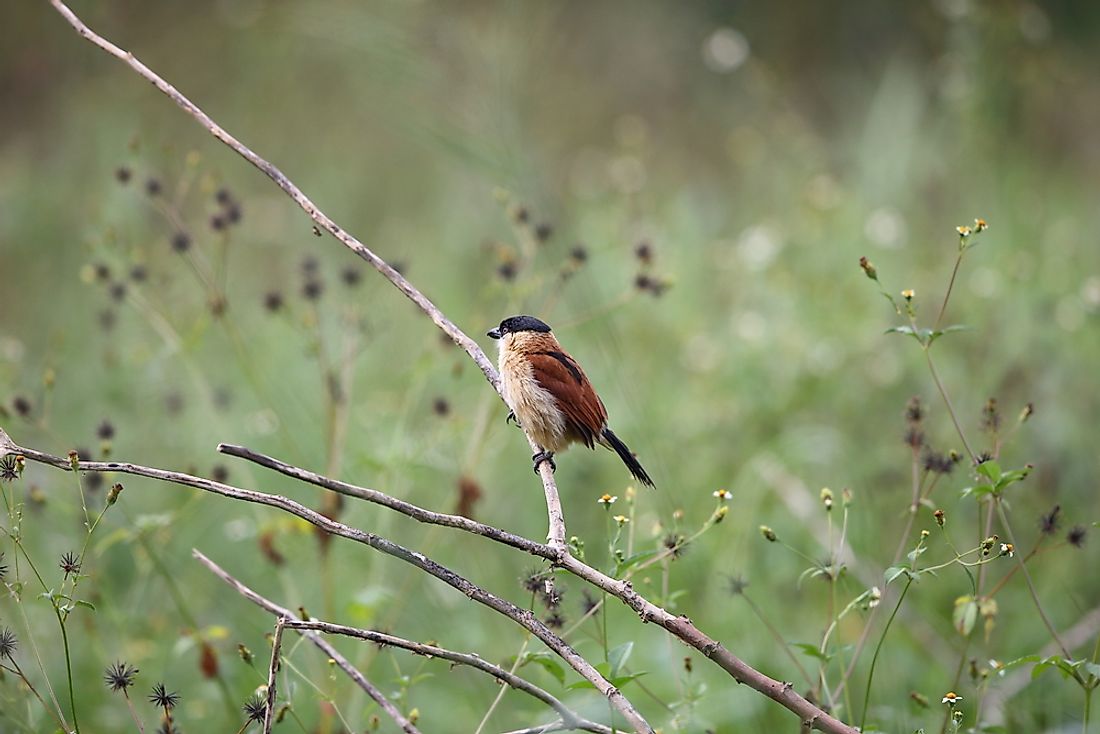The Native Birds Of Nigeria

Nigeria is located along the western coast of Africa and has a total area of 356,669 square miles. Within its borders are a wide variety of landscapes ranging from rainforests to coastal plains and mangroves to river valleys. These ecosystems host approximately 940 bird species, of which 5 are endemic. This article takes a look at some of the native birds of Nigeria.
Ibadan Malimbe
The Ibadan malimbe grows to lengths of between 6.5 and 7.5 inches, and has an interesting physical appearance. The male has a black body and a bright red head with a black mask over its eyes. Its diet mainly consists of insects and other invertebrate. Breeding season for this species is between May and August. Its population is estimated to be at 2,469 and rapidly declining due to deforestation. This bird is endangered and present only in southwest Nigeria.
Rock Firefinch
The rock firefinch is a bright red colored bird with darker colors tipping its tail and wings. Its beak is a bluish-grey color. This species mainly consumes seeds. It is endemic to the Jos plateau in central Nigeria, a habitat threatened by degradation and mining practices. Despite this, it is not listed as a threatened species.
Anambra Waxbill
The Anambra waxbill grows anywhere from 4 to 5 inches in length. The male is a soft brownish grey color with a reddish orange colored beak and rump, the spot just before a darker grey tail. This species lives in the sandy shores of rivers and estuaries and among tall grasses. Its diet consists of seeds. Breeding season for this bird is between October and November and occurs after the flood waters go down. First listed in 1988 as threatened, the Anambra waxbill has been a vulnerable species since 1994. This is due to its small population size, between 167 and 666 mature individuals. Currently, these numbers are stable.
Jos Plateau Indigobird
The Jos plateau indigobird is black with a greenish-blue iridescence, and grows to approximately 4 inches in length. Its diet consists of grass seeds. It inhabits the grasses and rocky areas of the Jos Plateau, a relatively small area. Despite this small range area, its population is not below 10,000 and therefore, it is not considered a vulnerable species. This species breeds between September and December, laying its eggs in the nests of the previously mentioned rock firefinch. The mother removes the same number of rock firefinch eggs as she has laid and leaves her young to be raised by the other bird.
Bush Petronia
The bush petronia inhabits dry savannas and tropical, dry shrublands throughout several African countries. Given its wide range and large population, this species and its population is considered stable. It is a very small, grayish-brown bird with a light line running from above its eyes to the back of its head.
Neumann’s Starling
The Neumann’s starling, also known as Neumann’s red-winged starling and Crag chestnut-winged starling, is solid black except for the reddish-brown coloring fringing the tops of its wings. It grows to between 10 and 11 inches and is found in small ranges just north of the equatorial line. Its diet consists mainly of fruits, especially figs and dates. In Nigeria, this species breeds in April and May. While nesting, it has been known to attack other birds to protect its young. Its status is not considered threatened due to its common occurrence.
For a list of some of the other birds native to Nigeria, see the table published below.
The Native Birds Of Nigeria
| Native Birds of Nigeria | Scientific Name |
|---|---|
| Ibadan malimbe | Malimbus ibadanensis |
| Rock firefinch | Lagonosticta sanguinodorsalis |
| Anambra waxbill | Estrilda poliopareia |
| Jos Plateau indigobird | Vidua maryae |
| Bush petronia | Petronia dentata |
| Neumann's starling | Onychognathus neumanni |
| Shining drongo | Dicrurus atripennis |
| Marsh tchagra | Tchagra minuta |
| Hamerkop | Scopus umbretta |
| Bateleur | Terathopius ecaudatus |







